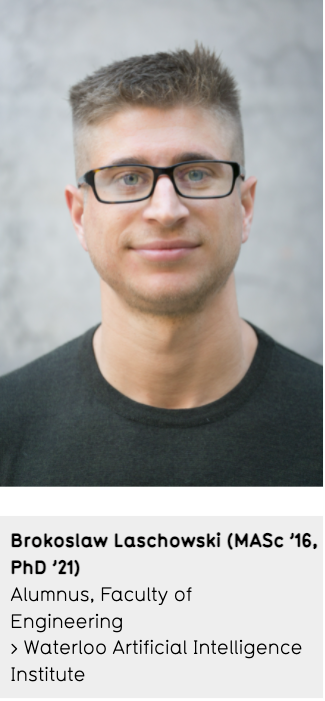Trailblazing research is transforming the field of rehabilitation medicine by developing robotic exoskeleton legs capable of autonomous control and decision making.

“I gained a deep appreciation for the awesome capabilities of individuals with different physical disabilities,” Laschowski says. “It was inspiring because here you have athletes that are not only performing at the highest level of sport, but also overcame significant sociocultural and physical barriers.”
Working with Paralympic athletes gave Laschowski the opportunity to study the engineering design and optimization of wheelchairs using mathematical models and computer simulations, with support from his supervisor Dr. John McPhee. His master’s research on high-performance wheelchairs led to his work on wearable exoskeletons that assist activities of daily living for his doctoral degree in Systems Design Engineering, again supervised by McPhee.
“I started to learn about the limitations in exoskeleton technology and where there is room for improvement,” Laschowski says. “Although these devices are promising, we don’t yet really see wearable robots being used in the real world.”
Bridging health sciences and engineering to create wearable exoskeletons
Laschowski addressed these limitations by developing ExoNet, a wearable system that combines computer vision and deep learning artificial intelligence (AI) for autonomous exoskeleton control. The development allows the robot to think and control itself without human intervention.
Until now, wearable robots operated by motors had to be manually controlled by a person using a smartphone application or joystick to select the desired locomotor activity.
“The purpose of our research is to alleviate the cognitive burden of having users to think and control the robot,” Laschowski says. “The wearable camera senses the state of the environment in real-time. Those images are then automatically processed and classified using an AI algorithm to not only recognize stairs and other walking terrains, but also predict the next movement while avoiding physical obstacles in the environment.”
“My PhD research also focused on the development of lightweight exoskeletons with energy-efficient actuators. Using efficient motor technology allows for lightweight batteries that work for longer periods while drawing less power,” says Laschowski, also a member of the Waterloo Artificial Intelligence Institute (Waterloo.ai).
Creating the dream team of robotics researchers
The University of Waterloo is home to 74 Canada Research Chairs who are experts in their respective field pursuing groundbreaking research. As a PhD student, Laschowski recalls having the unique opportunity to work alongside two Canada Research Chairs who are also professors in the Department of Systems Design Engineering — Dr. John McPhee, Canada Research Chair in Biomechatronic System Dynamics, and Dr. Alexander Wong, Canada Research Chair in Artificial Intelligence and Medical Imaging.
“It is an absolute honour to work with two Canada Research Chairs and that we created this dream team at Waterloo,” says Laschowski, who leads the ExoNet project in collaboration with William McNally, also a PhD candidate in Systems Design Engineering and a member of Waterloo.ai.
Laschowski recalls the moment when the AI algorithm started learning on his laptop computer after many iterations of the machine learning system. After feeling excited to witness the system teach itself over time, he remains positive that it could one day translate to support clinical testing.
“The success of this research project suggests that we’ve identified something really meaningful,” he says. “We were one of the first groups to pursue this research area back in 2018. Now our open-source image database is helping create a global impact on the international research community. Researchers across the world are developing new control algorithms for these wearable assistive technologies, for which our system can help advance.”
Laschowski completed his PhD in 2021 and will continue developing robotic exoskeleton technologies as a researcher at the Toronto Rehabilitation Institute and the University of Toronto.
“One day I could be seeing somebody walking down the street using a wearable robot and I think to myself — the dream team at Waterloo, we actually helped create that.” Taking a step towards self-walking robotic exoskeletons was originally posted in Waterloo News.
This research was also featured in the Waterloo Region Record article, University of Waterloo team produces self-walking robot exoskeleton for those with mobility impairment.